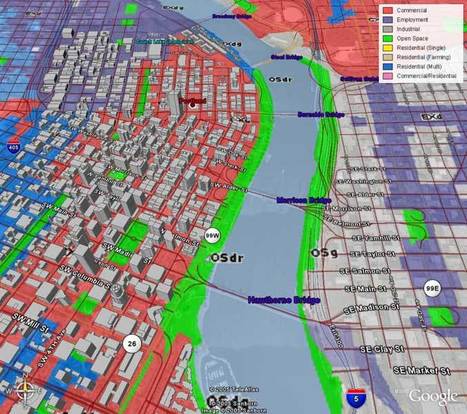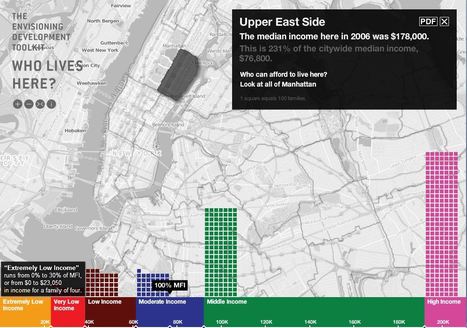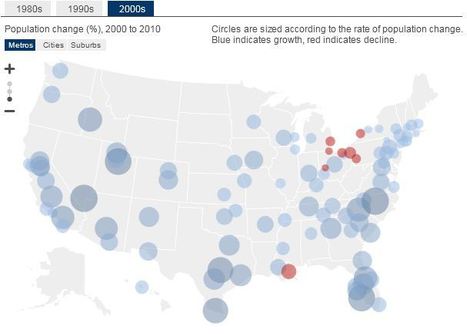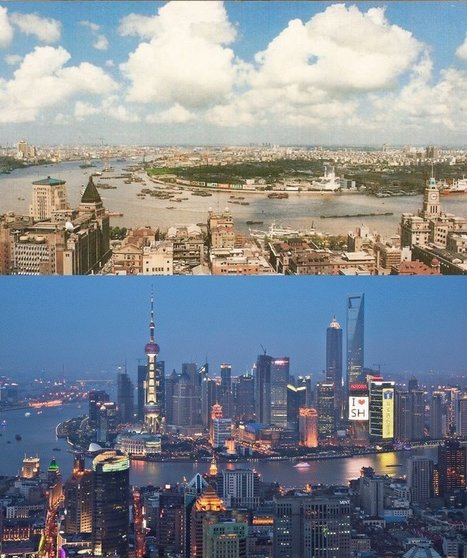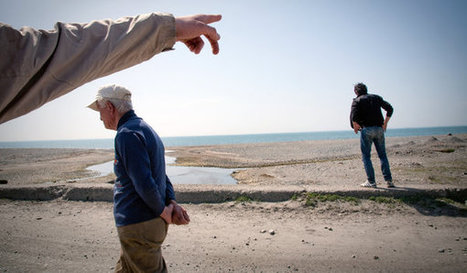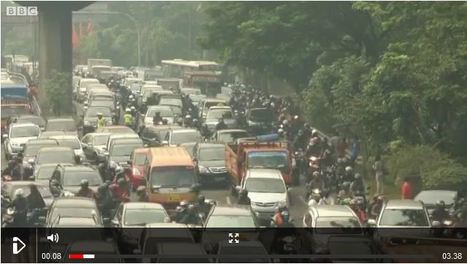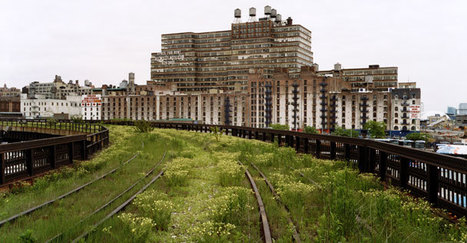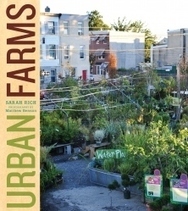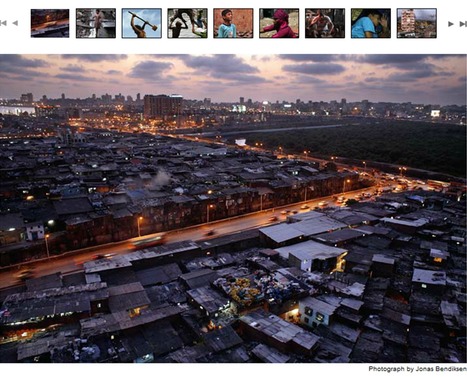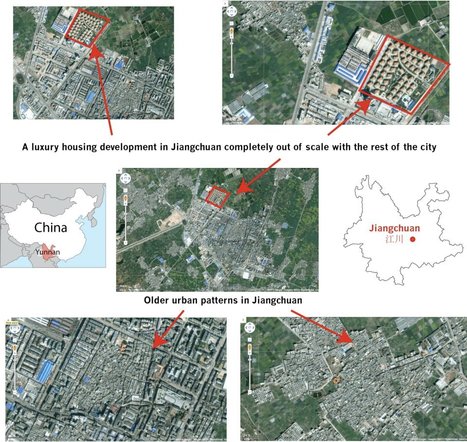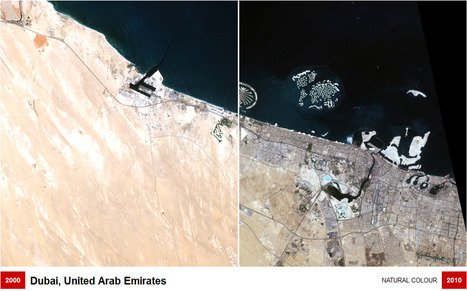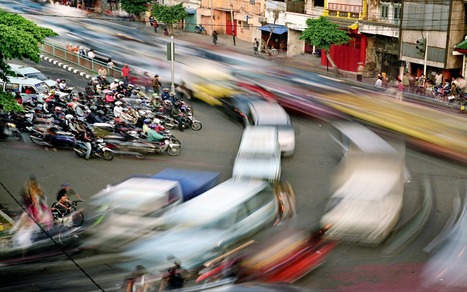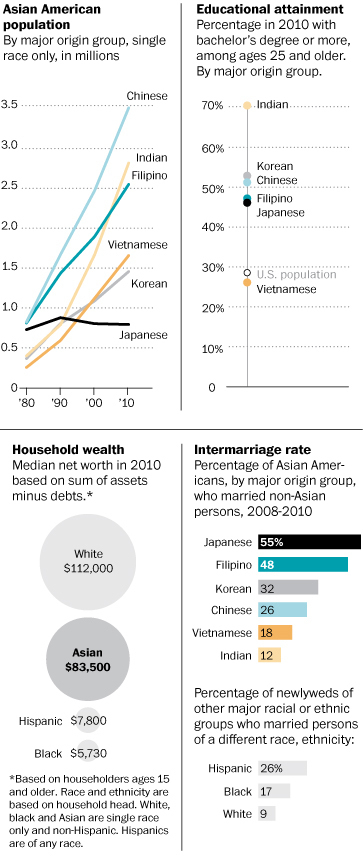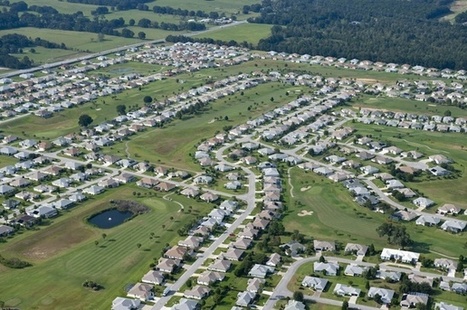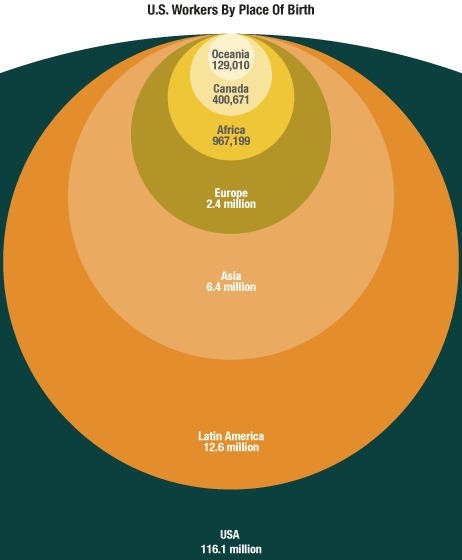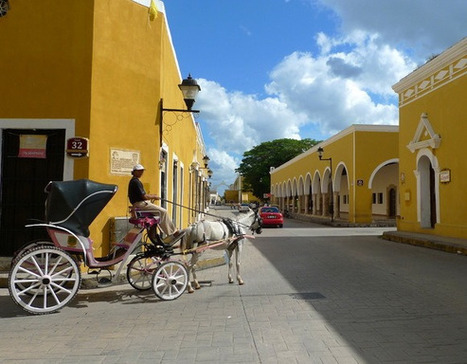The City, for the first time in human history, houses more of our species than the countryside. This fundamental fact means that geographers must study the city more. GIS offers many of the tools needed for that type of sustained inquiry. Geospatial technologies are no longer only for the 'tech geeks,' researchers or even the tech saavy; GIS and other technologies are a learning platform for 21st century geo-literacy.
Get Started for FREE
Sign up with Facebook Sign up with X
I don't have a Facebook or a X account
 Your new post is loading... Your new post is loading...
 Your new post is loading... Your new post is loading...

Rayden Duncan's curator insight,
October 2, 2013 11:38 AM
This relates to my topic in that it shows how the united states populaction moved into urban settings. It show cities are generally showing an increases in population. poeple would move to cities to find jobs or shorter commute.
Aleasha Reed's curator insight,
October 2, 2013 12:16 PM
This is a map that shows the rate of change in the U.S., population wise. The most growth occured on the western and eastern coast's. There were a few places with a decreasing population.
Adam Deneault's curator insight,
December 14, 2015 8:22 PM
Wow! All I can say is Wow! Shanghai overall in every way is highly indistinguishable from what it was in 1990. On the far side it is minimally developed and on the close side it has what looks to be a fairly modern city for the 90s. Take a jump twenty years and it is as if it was built the way it looks currently Even the side closest that was developed in the 90s, looks like it was scrapped and rebuilt to be even more modern, a mega city. Because of its strategic location and has a river for transportation, it is a transportation hub, which is why it has the money to do what it does.

Alex Vielman's curator insight,
December 15, 2015 12:46 AM
These two images are perhaps a goo example of how globalization has developed over Shanghai in just 20 years. The images show how once greener and more spacious the region looked before in 1990, and the other image shows how technology has developed and become an important priority to the people. There are huge tall buildings located in the area and the other natural source seen is the body of water surrounding some of the tallest buildings in the area. There is no longer any trees which is also a sign of how un-important or how simple to was for the Shanghai to knock them down to simply make more buildings. The concept shows how business has developed in the region but also shows the potentially jobs located here as well. Overall, this part of Shanghai is very economically stable but it is also important to see outside of the heart of the buildings. 
Matt Chapman's curator insight,
April 26, 2018 12:21 PM
Shanghai's growth over the last 20 years is remarkable and astounding. Globalization has come to China and China has grown vastly over the years, this is good and bad. Pollution and waste is a problem with large cities but it also shows wealth and prosperity.
Kendra King's curator insight,
April 13, 2015 9:01 PM
Humans instinctively look to profit when the situation arises, this is one of those situations. The government implemented regulations that barely seem to manage the traffic jams, i.e. having 3 people per car. Since people do have to work and may not always be able to meet the requirements, others have started making a living as a “jockey,” an individual who offers to ride in a car so the 3 people limit is met. Doing this is considered illegal. Yet, there aren’t good enough jobs for people to work (otherwise they won’t be a jockey) and those who do work can’t seem to always follow the rule without it harming there work life. Plus, more police now turn their attention towards these people thereby deterring them away from their other duties. I realize that the state probably never intended these consequences to happen, but now that it is I really wonder just how useful this law really is. One thing is certain though, without better planning or economic innovation by the government, the jams will continue to happen.
I find it odd that the people keep staying despite the major traffic problem. As one interviewee mentioned. I guess as long as you can find ways to stay productive and still receive enough compensation, the time spend in traffic isn't enough of a hassle for them. As someone who has enough economic opportunity with far less wait time in traffic though, I would find this situation unbearable. Clearly, this isn't that case though. So, I am not sure of the immediate solution. As we learned in class, the government tried transmigration. This just lead to more problems. It was then suggested that the type of opportunity. If that is the case though, what should the government do now? Waiting for a more natural economic opportunity to get the people out of Jakarta won't happen quick enough to curb the increasing population growth. Therefore the strain on the infrastructure will continue because the population's carrying capacity is exceeded. Whatever the answers, I think this would be a great case study for urban planning and the impact raising car dependency has on a society as this driving nightmare shows just how important planning is with more cars. 
Matt Chapman's curator insight,
April 26, 2018 12:42 PM
Traffic is a show of heavy urbanization. This shows just how urbanized Jakarta is and how many people are working and moving around the city.

Taylor Doonan's curator insight,
May 3, 2018 12:42 PM
Jakarta makes rush hour in America look like a walk in the park, it is almost constantly busy and there are strict rules about who can be on the roads, such as there must be a certain number of passengers in a car and taxis are monitored. These rules cause residents to go to extreme measures, people often stand and get paid to be passengers in peoples cars so they meet the passenger requirement and that is how some of the residents of Jakarta afford to live. There are also many unregistered taxis that take the risk because registering them is difficult to do.

Alison Antonelli's curator insight,
December 4, 2013 11:12 AM
I personally think that farms go unappreciated. If we did not have farms we would not have half or any of the food we have today. This interview puts a lot of things into perspective on how farms can help out our cities and improve the overall food industry.

John Nieuwendyk's curator insight,
October 26, 2014 9:06 PM
Kabul, a once thriving city is now the product of a war torn Afghanistan. During the fighting mass exodus left the city empty and uninhibited. However, after the war civilians fled back to the slums of Kabul in search of job opportunities. With little infrastructure, no electricity, no water due to evapotranspiration and deforestation and a serious overcrowding problem, residents lack the essential resources needed to survive. Due to the cities destabilized economy corruption runs rampant, in consequence it is unsafe to live in the city center. The advocation for city services is high upon the minds of the people. In response, compounds have been made in the foothills to house impoverished people. These compounds will help the overcrowding problem but the informal economy and dangerous shortcuts will further cause destabilization and create an unsafe city center.
Samuel D'Amore's curator insight,
December 16, 2014 1:32 AM
This audio clip provided a detailed view of the capital of Afghanistan, Kabul. It doesn't speak of the city architecture instead it focuses on the failing logistics of the city. It talks about resource shortages and the sheer amount of people crammed within the city. These problems are largely caused by an influx of refugees from the war torn countryside flooding into the city for safety and work. This clip shows the Kabul of today, a ghost of its former prestigious self.
Adam Deneault's curator insight,
December 14, 2015 3:37 PM
A war torn country of Afghanistan's capital city Kabul is in the mountains. With a population of five million people, the cities infrastructure is in ruins. Things we take for granted, water, sewers and electricity are all in short supply for Kabul. There is lots of money coming in to the country from corruption of opium trade. Due to terrible construction, it is assumed that when Kabul has their terrible earthquake that there will be much destruction. Cars pack streets that are unpaved and the streets are five to ten times more packed than they are planned out to be. Just to get from one side of Kabul to the other it can take hours. What the government needs to is control immigration and fix the problems that they currently have. |

Daniel Lindahl's curator insight,
May 25, 2015 1:55 PM
This article illustrates not only Las Vegas's sprawl, but also Vegas-style diffusion. By creating a time-lapse, a clear illustration of Vegas's diffusion is shown.
Jessica Rieman's curator insight,
April 23, 2014 4:44 PM
In this description followed by images there are all types of vintage points in order to show a clear image of where in relation a time and place a certain society/ country is and to give some background info on what you are looking at by seeing it in multiple images.

Brett Sinica's curator insight,
October 8, 2013 3:36 PM
Day to day, even looking into next year the rate of 2 millimeters per year may not seem drastic. To a city that has been around for hundreds of years, it's assumed the city plans to stay standing for hundreds more. Considering the age of the city, say in a couple hundred more years, some buildings could begin to take in water. It is also possible that certain parts of the city could be sinking faster than others. There is a similar situation in Mexico City where it was built on a lake and each year that source diminishes due to the demand of water by its residents. Certain parts of the city are sinking and some buildings are slanted due to the results. These cities are beautiful but reality shows that as time passes, it will probably only get worse. Hopefully preventions can be taken to at least reduce the speed of sinking so that people after us can appreciate the architecture and atmosphere the city has provided all these years.
Jacob Crowell's curator insight,
December 8, 2014 12:11 PM
Venice is a city that capitalized on its geography and developed canals so the city could grow despite being so close to sea level. Now that sea levels are rising, Venice is in trouble because its survival is dependent on the water levels, as they become out of control Venice will not be able to withstand the change. There are similar circumstances like in the Maldives where global warming and rising sea levels will put entire countries under water.
Kendra King's curator insight,
February 15, 2015 6:58 PM
As you mentioned in class, we are living on constantly moving land features. In the case of Venice, the water is moving in on the city so it is actually sinking and has been for quite some time. What is new to the equation is that it might be sinking “five times more than” originally “calculated or “7.8 inches every hundred years.” I say might be because there are others who quibble about this new find, saying it is inaccurate. Also, there is a damn project in the works to try and combat the sinking. While I am happy that the city is working on slowing the process, I am curious to know what their solution is going to be when the city finally does go under. As I was reading this all I could think of was saving all the rich art and history that this Italian city is famous for. In some ways it is great that the city knows ahead of time that it is sinking because they have time to plan a way to save the important aspects of the city. On another hand though, the city is so below sea level that a natural disaster could cause far more damage than anyone could have foreseen. I just hope that doesn’t happen anytime soon because Venice is definitely on my bucket list.

Joseph Thacker 's curator insight,
April 6, 2014 11:23 PM
Dhaka is the fastest growing city in the world, as rich and poor people move to the city everyday. So many poor people are moving here due to the fact there is no other place worth living in Bangladesh. The city is facing many problems, such as lack of traffic signals, minimal clean drinking water for residents and horrible housing for many people. However, some feel the city’s slums offer the best chance for an improved life. 
Sarah Cannon's curator insight,
December 14, 2015 10:48 AM
There is a lot of poverty and pollution in Dhaka. The demands for energy and water are high in Dhaka as well. I personally don't see how these people and migrants can live in such a polluted and dirty place and the reason why I can't imagine living in such a place is because I never have. I'm lucky enough to not experience poverty and I greatly appreciate my life and home. Hopefully things improve in Dhaka and places like Dhaka. Hopefully there will be less pollution and poverty in the future any where in the world.
Stevie-Rae Wood's curator insight,
December 9, 2018 5:42 PM
Dhaka is the highly overpopulated city in Bangladesh. Dhaka is one of many megacities that can food production cannot keep up with the influx of people. Dhaka is home to 15 million people. Which is crazy because its not a country its a city within a country. It is one of the fastest growing megacities but also one of the poorest with slums around every corner. People gravitate to Dhaka because of the many natural disasters that ruin peoples only source of income and food their land. People ultimately will have no other choice but to move to this megacity in the near future.
Macy Nossaman's curator insight,
September 20, 2013 2:26 PM
This is a good article about immigrants in America because it talks about all of the different places people have immigrated from and now live and work in the U.S. Since my topic is European Immigration, It shows that there are 2.4 million Europeans currently working in the U.S.
Laurel Stelter's comment,
September 27, 2013 2:23 PM
I think that this is a really interesting article. The two pictures really help define America and its workplace well. It surprised me how many people weren't born in the U.S., but still work here.

Olivia Campanella's curator insight,
September 19, 2018 11:46 AM
We all love to see the cities and town around the world of very striking and different colors, but in this article it gives a list of 8 very stunning one-color towns.
1. Juzcar, Spain. This town is painted blue to celebrate the premiere of the Smurfs movie in the Spring of 2011. 2. Izamal, Mexico. This town is painted a mustard Yellow. The settlement is known in Yucat'an as the "Yellow City". 3. Jaipur, India The town also nicknamed "The Pink City" is the capitol city of the desert state of Rajasthan. The color pink became part of the city. 4. Jodhpur, India This city is known as the Blue city because every house is painted blue so from above it looks like a little blue spot in the middle of the Thar desert. 5. Collonges-la-Rouge, France This is a very attractive and very popular city where visitors come. The color red is the first thing you will notice because all the houses are made from the local sandstone. 6. Piodao, Portugal This is Portugal's most typical city with houses built from local materials. Slate walls, roofs covered with stone slabs and brown wooden doors and windows. 7. Ubrique, Spain These houses are painted white to reflect the heat from the hot sun and keep the interiors fresh. 8. Chefchaoen, Morocco This town is noticed by the houses painted in different shades of blue. In the 1930's Jewish refugees who fled Europe revived this town with tinted blue whitewash. |




